Let me go back a couple of years to a report I saw about the Nurnberg Toy Fair. It announced the introduction of a large Hirobo Bell 430 with a 40cc gas engine in an ARF fuselage. It looked gorgeous so I ordered one from Jeff Green at MRC Altech. Well time went by and I forgot all about it until one day last fall, two large boxes arrived on my doorstep. I tore open the bigger one and there was the fuse, complete, but unpainted. The other box contained the mechanics with a gorgeous set of retracts. I knew I wasn't going to have time to do this model justice with upcoming commitments, so I gave the whole lot to Joe Howard of East Coast Scale Helicopters and asked him to build and paint it for me. What an excellent move that was! At Sanford this year, he delivered this gorgeous model with paint like glass. If you need a model painting, he is definitely the man to talk to
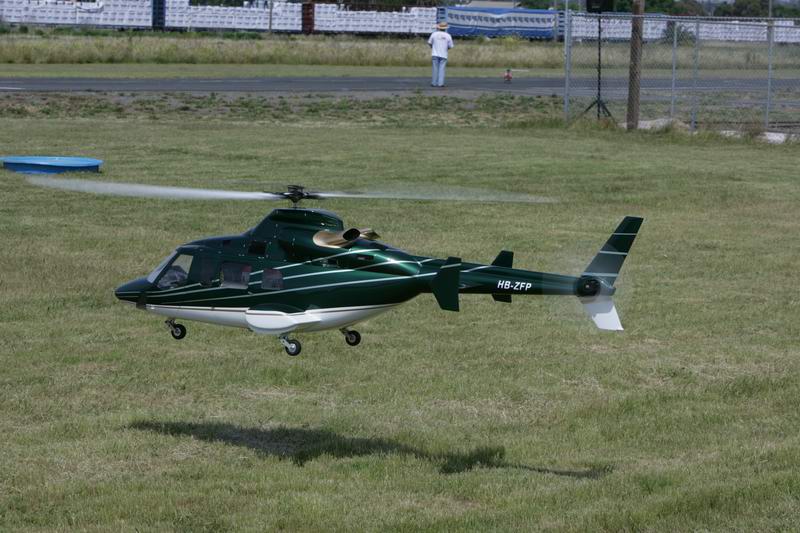
Gasser guru Bill Meador was at Sanford and he helped me get the motor setup but it melted a main gear rather quickly so tuning was shelved. I managed to get the new one fitted and met Bill at Sulphur and we continued the tuning. It was a motor Bill wasn't familiar with and I have burnt out every gas motor I ever owned so we gingerly started from a rich condition and progressively leaned it out while running the motor in. When I left Sulphur, the motor was just a tad rich and Bill said it wanted to run at 1450 rpm on the head. That's how I left it, but the instructions said 1400 rpm on the head and use a governor.
When I flew it at Circumgyration, the temperature was 10 degrees cooler and the motor was running happier. I was enjoying flying this big smooth flying bird around in the sky and then I came in for a descent from height and a resonance setup in the tail boom. I and everyone else thought the tail was going to come off, it was that bad. I added some pitch which loaded the motor up again and the resonance stopped immediately so I gingerly brought her down and landed. A quick tweak on the middle and high throttle setting in the Tx and it was off for another flight. This time she was fine but the tracking was out. When I landed to adjust the tracking we noticed that one of the link rods was bent where it had touched the doghouse during the resonance, so it was shut down and check it all over time.
During the drive out one of the retracts had ceased to work properly so I had to pull all of the mechanics out to get at that and while I had them out sitting on the bench I had an epiphany (that's today's buzz word isn't it?) I don't like gas motors. They don't sound right in a turbine heli. I don't know enough about them and to me they are too old a technology for me to want to learn.
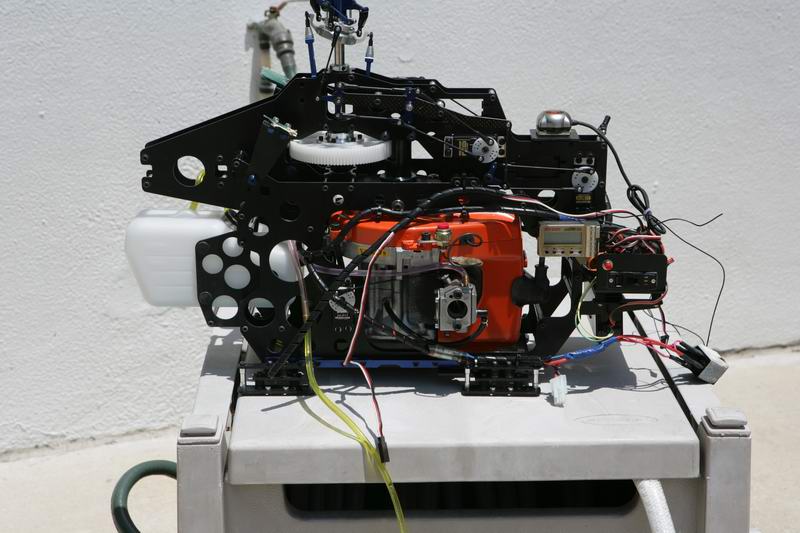 These are the mechanics, just look at the size of that motor. I decided to go electric! This is what I am going to replace that giant overweight gas motor with.
These are the mechanics, just look at the size of that motor. I decided to go electric! This is what I am going to replace that giant overweight gas motor with.
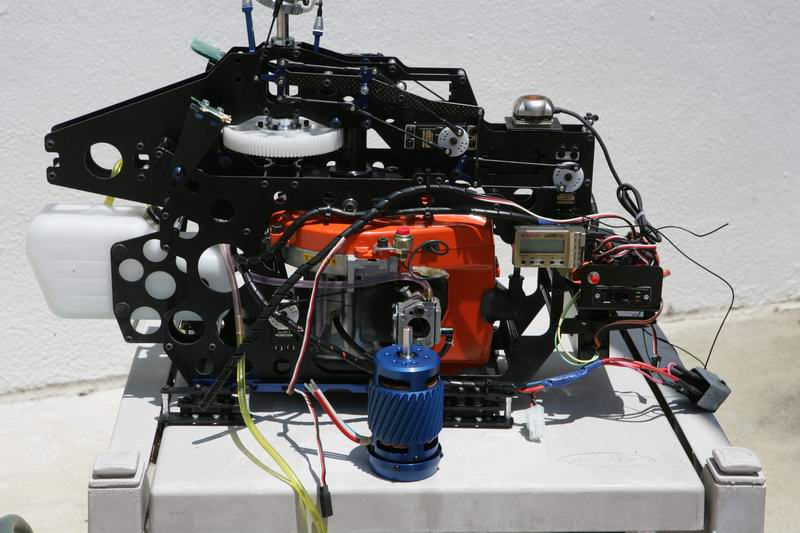
That tiny blue motor is a Plettenburg motor from Germany which makes 3.7HP when used with 42 volt LiPo batteries and a Schulze 160 Amp controller. Make no mistake, this is not a cheap conversion as the batteries, motor and controller cost $2000 but I think it will be worth it. Just in case it doesn't work I have ordered a new clutch bell from MRC so I don't have to wreck the old motor getting the drive pinion off it, and I will have to do some tests to see what gear ratio I need to get the head speed to run at 1400 rpm at 80% throttle on the governor. I intend to use a Robbe belt drive reduction gear from the motor to the pinion and my home made propeller test rig showed that the motor had a maximum speed on the "slow " setting of exactly 20,000rpm. I believe the fast setting on that setup would have the motor running at over 100,000 rpm, for a short time anyway!
The pinion is 12 tooth and the main gear is 97 teeth giving me a reduction of 8.08:1 and if I want to have a maximum head speed of 1400 rpm I will need to gear the motor down by a further 1.77:1. The nearest I can get is by using a 42 tooth driven pulley and a 23 tooth driver which will give me a head speed of 1355 rpm. If this proves to be too slow to fly the heli nicely I can always increase the number of cells in the battery pack and that will increase the motor rpm. This is the test rig I made up, with my home made "propeller" and an airplane tach stuck onto the motor under the prop.
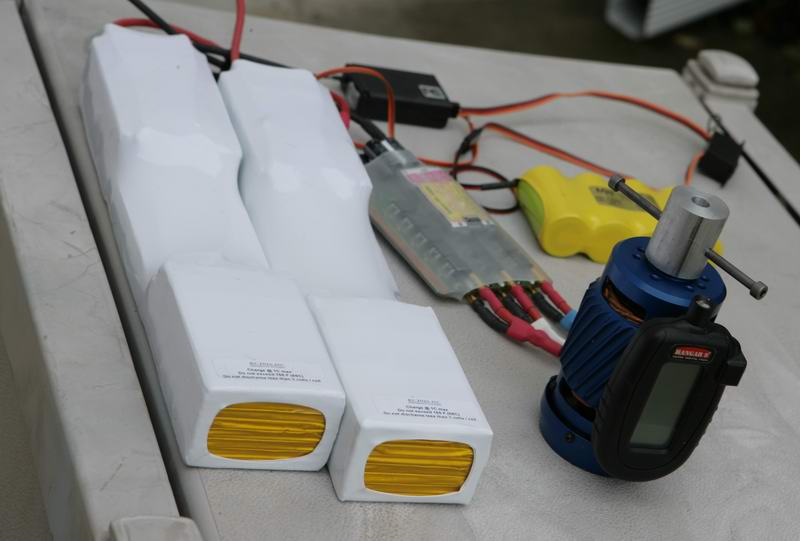
This was how the reduction system worked. I did put a tensioner on the other side of the belt to ensure it didn't jump, and of course, the rest of the frames were replaced. The beauty of this system is that it is very easy to get the entire drive train out by removing only 4 screws.
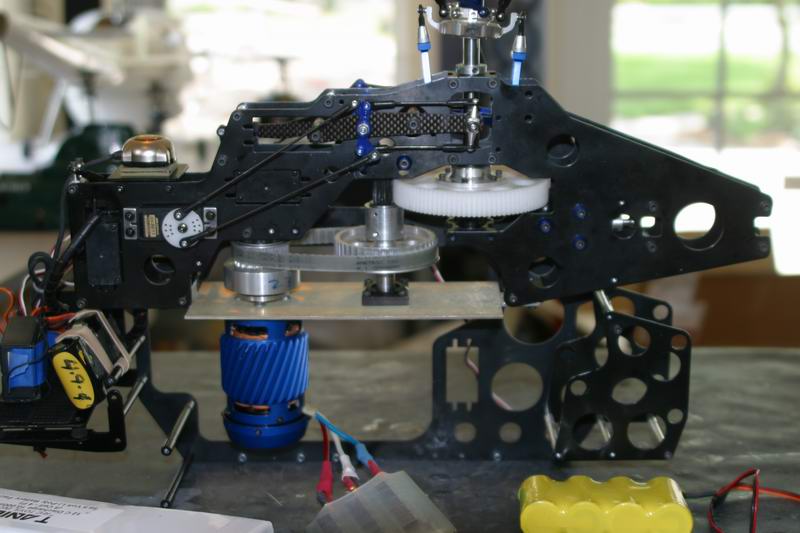
The controller works in an unusual manner and it has really only 2 options once in heli mode. Either you run it in "constant " mode as they describe it, which requires a throttle curve, or you run it in "governor" mode. I tried it in constant mode first to see what would happen and ended up hovering at around 1100 rpm with a maximum head speed of 1320. It was not a nice heli to fly so I ended up pulling the mechanics and fitting them to a metal trolley so I could make rapid changes and check them immediately. I knew that the heli would fly with 5 degrees of pitch at 1400 rpm and needed a maximum of 9 degrees to be able to climb out satisfactorily so that was my target.
First I put the controller into governor mode and ran it at 9 degrees of pitch and the maximum rpms I could sustain was 1150. Easing off the pitch kept the rpm at 1150 so I knew In was on the right track but the gearing was wrong. A 25 tooth pulley gave me 1220 and then I tried a 27 tooth pulley which was the highest I could get. That gave me 1360 at hover and 1260 on full climb out. My trolley nearly left the ground on a fully charged battery!
The motor was very hot after a 10 minutes run, the batteries were warm to touch but I could keep my hand on them, and the controller was cool. This told me the motor was getting near its limit and the batteries were giving loads of power, and the controller was almost continuously turned on. Later calculations showed that the motor was taking an average of 60 amps during the entire test and at 42 volts it made 3.4 HP. That was its limit.
So, I put the mechanics back into the model and had a test hover. It was a bit windy due to hurricane Arlene having just passed by, but the model hovered nicely with plenty of power for climb outs. It really needs some heavier blades to help it become more stable in the hover and that's the next thing on my list, but the blades grips are narrow and my choice may be limited. However, I know I don't need to change the gearing to get a higher head speed, its just fine like it is so mechanically its all done and ready for action.
I decided to try a 12S 4P pack to see if that would help the situation. I bought 2 1s 4p packs which fitted in the bottom of the fuse perfectly. The theory is that it requires a fixed amount of power to lift the helicopter and so if I use a higher voltage, it will take a lower current. The motors rpm is entirely voltage dependant if the load is within limits so increasing the voltage will increase the rpms, allow me to reduce the pitch and keep the load on the battery the same but at lower current. All very complicated stuff so I invested in a device called a Watts Up which measures volts amps and watts and displays them continuously, but also remembers maximums and minimums so I can see what the peak current and the voltage drop are later on. Testing showed that I needed to reduce the governor setting to 35% and this gave me a locked in 1400 rpm on the head. The MC-24 has +/- 150% range so 35% equates to about 60% on a scale of 0-100. Having the extra 40% capacity means i have plenty of room to spare to pull pitch with if i get into trouble.
The other thing this model is crying out for is a 4 blade head so I ordered an OF head and blades from Starwood scale models to fit to it once I get the 2 blade system flying nicely. I did try a 4 blade system on a Maxi Joker and it would not start up due to the tremendous torque needed to get the blades moving from a standstill causing the controller to over amp and cut out. The system I have in the 430 uses a clutch so it should take a lot of the load off the motor initially and help with the startup procedure. I set the mechanics up on the trolley again and fixed the sub frames down to the trolley with 16 thick ty-raps. I spooled it up gently on 0 pitch and just before 1200 rpm all hell broke loose. The mechanics started to wobble violently side to side and before I could do anything it tore the ty-raps off and threw itself on the ground. Fortunately the damage was minor, a bent main shaft and the head was damaged with one blade. A new main shaft was soon fitted and the original head put back on. I feel sure the problem was caused by the very soft rubber mounts needed to isolate the body from the vibrations caused by the gas engine, but frankly, the heli is a delight to fly like it is so I will leave it that way.
Meanwhile, the fuse had been back to Joes shop to have the paint cracks in the tailboom fixed and when it was returned I made very sure the top of the mechanics was securely fasted to the body with some stout brackets. The whole machine was very carefully assembled and the retracts system rebuilt to remove any leaks. The capacity of the cylinder to hold air was altered from 7 minutes to 4 days by careful replacement of parts. The retracts are set to work only on idle up 2 and I hope to get some pix of the model flying around with them up, it looks gorgeous. I am getting about 15 minutes flying on a charge so a couple of 7 minutes flights is great.
One other mod I made was down to Model Helicopter World. I read about how to reduce the switch on spark in there and as I was using big batteries the spark on my connectors was wearing them out rapidly. The secret is to make up a parallel connection with a 100 ohm resistor in series. This charges up the capacitors and then once they are charged, after about 5 seconds, you can connect the main connector with no spark at all.


 These are the mechanics, just look at the size of that motor. I decided to go electric! This is what I am going to replace that giant overweight gas motor with.
These are the mechanics, just look at the size of that motor. I decided to go electric! This is what I am going to replace that giant overweight gas motor with.


